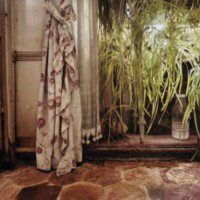For each of us, there exists a moment we will cease to exist. Some of us will have time to prepare, perhaps days or months on account of a diagnosis, perhaps seconds or even a full minute with the knowledge that the wing of this plane is on fire and it has become a bullet about to pierce the unforgiving ground. In an instant most of us will leave behind a home, a bed made or unmade, a basket of laundry, dishes from last night or a week ago, all manner of things unfinished, dirty, in disrepair. I worry about that. Sometimes, I anxiously return to the house from my car before leaving to wash a dish or clean up a mess lest I die in traffic. Few will die leaving an immaculate home, bills taken care of for the month, clothes freshly hung in the closet, organized by season then by color. Even fewer will have a photographer come through only days after our death, photographing things exactly as we left them.
I have a fascination with the places we live and the lives we leave behind. Perhaps because I have so often found myself sorting through a loved one’s artifacts, attempting to convince myself I don’t need the costume jewelry clip-on earrings my grandmother bought in 1956, my brother’s backup guitar strings, my mother’s size 10 shoe or her bras, all of which I kept. Not forever. But for a while. I still have my grandmother’s clip-on earrings.
When French novelist and filmmaker Marguerite Duras died on March 3, 1996, she was probably as prepared as any of us can be. Between November, 1994 and August, 1995 she had written a short, 54 page impossible to find book aptly titled That’s All. Its last entry was dated August 1, 1995 and reads:
“I think it is all over. That my life is finished.
I am no longer anything.
I have become an appalling sight.
I am falling apart.
Come quickly.
I no longer have a mouth, no longer a face.”
A few short months later, she would be gone. A few days after her that, her home would be photographed by Lise Sarfati. Last week, I was at LACMA and found myself drawn to a dead-end hallway off of a room holding Egyptian artifacts, coffins, a mummy. It was while I was standing with the mummy that the dead-end hallway caught my eye. I wandered over and was immediately captivated by the images. I was halfway through looking at them before I knew I was looking at the home left behind when a literary icon left this world. The images are gritty. There is a sadness to them, which is fitting if you are familiar with Duras. Her home is sparse, like her prose. There is a sense that everything is intentional, even the disrepair. There is a box on a table, as though she may have been putting things away so someone else didn’t have to. There are flowers still in vases. I tried to read the titles on her books; in me was a deep yearning to know what she had been reading that she left unfinished, since she considered her writing complete. Still, this was the place she wrote and it is nothing like I imagined. Few things are the way we imagine them to be but this somehow hasn’t left me. I’ve been thinking about it all week. I’ve been thinking about the place she wrote, the place I write, the place we all do the things that make us who we are and what they will look like in the moment we are no longer.
You can see Lise Sarfati’s photos of Duras’ home, titled Post-Factum in the Hammer Building at LACMA (3rd floor), through April 27, 2014 or, online at Rose Gallery.





One response
Sometimes I think it’s because I’ve taken so many history courses why I care about archives, or clocks on shelves, or stacks of books in disarray. Sometimes I’m preoccupied with death, so I think, “Is this how my life will look to my children if I’m suddenly gone?” Odds and ends everywhere. No real order. Just an old file cabinet given to me that belonged to a World War II artist, where I’ve thrown all my papers.
I really love this piece. I love that Sarfati cared enough to take photos, that so many writers lives and deaths have their place in history and art, not just in what is published or tucked away in literary archives. Pieces like yours remind me that spirits might navigate these pages too, grateful they’ve been remembered yet again, because they once loved words so much.
Click here to subscribe today and leave your comment.